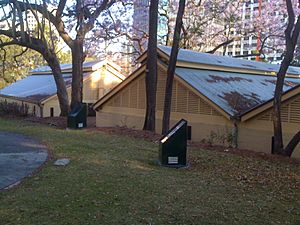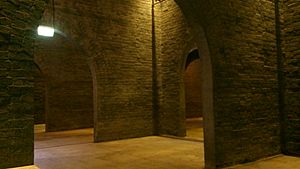Spring Hill Reservoirs facts for kids
Quick facts for kids Spring Hill Reservoirs |
|
|---|---|

Spring Hill Reservoirs, 2015
|
|
| Location | 230 Wickham Terrace, Spring Hill, City of Brisbane, Queensland, Australia |
| Design period | 1870s - 1890s (late 19th century) |
| Built | 1871 - 1882 |
| Official name: Service Reservoirs | |
| Type | state heritage (built) |
| Designated | 21 October 1992 |
| Reference no. | 600174 |
| Significant period | 1871, 1882 (fabric) 1870s-1880s, 1900s-1960s (historical) |
| Significant components | tank - reservoir |
| Builders | Henry Holmes |
| Lua error in Module:Location_map at line 420: attempt to index field 'wikibase' (a nil value). | |
The Spring Hill Reservoirs are two old underground water storage tanks located in Wickham Park in Spring Hill, Brisbane, Australia. They are close to the famous Old Windmill. These reservoirs are also known as Service Reservoirs. They were added to the Queensland Heritage Register on 21 October 1992, which means they are protected because of their historical importance.
The first reservoir was built in 1871. The second one was built just a few metres away eleven years later. Both were made mostly from red bricks and mortar, built deep underground. Inside, they have columns and arches that help make the walls stronger. When they were planned, Spring Hill was a great spot for Brisbane's water supply. This was because it was higher than most of what is now Brisbane CBD. Water came from Enoggera Dam and flowed down to the reservoirs using gravity. Henry Holmes built them in 1871 and 1882. They supplied water to Brisbane City until 1962. Today, three small hut-like buildings cover the reservoirs above ground. For many years, the reservoirs were locked and people couldn't go inside. But since 2014, they are sometimes used for special cultural events.
Contents
Brisbane's Water Story: A Look Back
These reservoirs were a key part of Brisbane's second big step in getting water to its people. Before this, people mostly got water from rivers, wells, and tanks. There was also an old dam built by convicts and a wooden pipeline. But the water supply was often not enough and sometimes dirty. This became a big problem when the Brisbane Municipal Council was formed in 1859.
Early Water Challenges
Even though people argued a lot about the best way to get water, a new system was built. This system brought water from Enoggera Dam between 1863 and 1866. It was the first time water flowed through pipes by gravity in Queensland. It was also the first big engineering project for the city.
Building the Reservoirs
The Mayor of Brisbane, Thomas Blacket Stephens, suggested building a reservoir on Windmill Hill (Wickham Terrace) in 1862. But they didn't have enough money at the time. By 1871, Brisbane's population had grown, and the water pressure wasn't good enough. So, the first reservoir was finally built. Henry Holmes was the main builder.
More complaints about water led to the second, larger reservoir being built in 1882. This one helped supply water to areas like South Brisbane and Kangaroo Point. Other improvements were made too, like the Gold Creek Dam in 1885-1886. Another reservoir was built in Highgate Hill in 1889, but it was made of concrete, not brick.
Changes in Water Supply
In 1893, the Mount Crosby Pumping Station started working. This meant water could be pumped to higher places, and gravity wasn't the only way to move water anymore. The Spring Hill reservoirs weren't used much after 1886. But in 1903, a new plan suggested using service reservoirs again to help with water pressure.
So, in 1904-1905, the Spring Hill reservoirs were fixed up. They were reconnected to the original Enoggera water pipe. Roofs were added to stop algae from growing in the water. The reservoirs were an important part of Brisbane's water system for almost a century.
End of Service
On 3 September 1962, the Spring Hill reservoirs stopped being used. They were not big enough or high enough to supply water to the growing inner city with its new tall buildings. In the 1980s, there were ideas to turn the area into an art gallery or a theatre.
Modern Use: Opera Underground
In 2014, a group called the Underground Opera Company performed inside the reservoirs. They spent three years cleaning them first! The tickets sold out quickly. The company then made a deal to keep using the reservoirs for opera shows until 2017.
Reservoir Design and Features
The low, rectangular buildings with sloped roofs behind the Old Windmill Tower hide Brisbane's first underground water tanks. The smaller, older building has one sloped roof, while the larger, newer one has two.
These disused reservoirs are dug deep into the top of the hill. They are like two big boxes, divided into sections by tall arched walls called baffle walls. They have cast-iron pipes for water to enter and leave, and special rooms for valves.
Because they were built with brick before concrete was common, this design was needed to hold back the pressure from the earth outside. The inside walls were covered with a smooth layer (rendered) to stop ground water from leaking in. The corrugated iron roofs, added later, have lots of vents along the top. They also have wooden-louvered gable ends and doorways with iron ladders going down. These roofs were once painted with bright stripes.
These reservoirs were built to store water from the Enoggera Dam and improve water pressure in the city. They played a very important role in Brisbane's first water supply system for most of a century.
Art Installation
In 2017, the site was used for an art show by Meaghan Streader. It featured cool neon lights inside the reservoirs.
Why They Are Heritage Listed
The Spring Hill Reservoirs were added to the Queensland Heritage Register on 21 October 1992. This means they are important because they meet certain rules.
Shows Queensland's History The Spring Hill reservoirs show how Brisbane grew, how living standards improved, and how local politics worked when Queensland was a new self-governing state.
Rare and Unique In Queensland, these are the first of many underground reservoirs. But they are special because they are the only ones known to be built with brick and arched walls, instead of concrete.
Can Teach Us About History The hidden pits, rooms, and pipes, along with where two old houses used to be, can still give us clues and technical information about the past.
Good Example of Their Type Compared to other reservoirs in Australia, these are a great example of their kind. They are similar to some in Adelaide, showing important ways they were built.
Beautiful and Special The reservoirs have always been a nice part of the "Windmill Hill" area, which also has the old convict windmill and parkland. Inside, the dimly lit, echoing spaces feel very grand and special.
Shows Great Skill As a key part of the Enoggera water system, these reservoirs were a simple but clever way to get enough water. They show great technical and creative skill from the early days of the colony.



